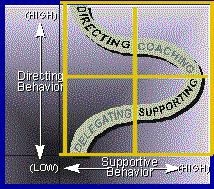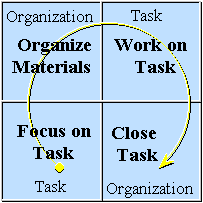Two Dimensional Performance Modeling
Models are simple diagrams that help us to visualize a concept. For example, Blake and Mouton's Managerial Grid uses two axis—“Concern for people” (vertical axis) and “Concern for task” (horizontal axis). Both grids have a scale of 1 to 9:

By plotting the concern that a manager has for people and tasks along the two axis, you can determine the managerial style:
- Authoritarian (high on task, low on people)
- Team Leader (high on task, high on people)
- Country Club (low on task, high on people)
- Impoverished (low on task, low on people).
In the above example, we identified the points on two dimensions, people and task, to find one place within a quadrant model. Another example is Hershey and Blanchard's Situational Leadership Model (SLM) that is built upon two dimensions of coaching—supervision and arousal:

- Supervision (directing) - The employee's skill and knowledge level determines the amount of supervision (what Blanchard calls “Directing”). On one end of the spectrum is over-supervision; on the other end is under-supervision. Under-supervision leads to miscommunication, lack of coordination, and the perception by subordinates that the leader does not care. Over-supervision stifles initiative, breeds resentment, and lowers morale. The goal is to provide the correct amount of supervision and this is determined by the employee's skill and knowledge level.
- Arousal (supporting) - The task performer's skill and knowledge level also determines the amount of arousal or emotional support required (what Blanchard calls “Supporting”). This support or cheerleading raises or lowers the task holder's arousal level (the inner-drive within our self-system). The arousal level determines the amount of motivation that drives our behavior. A certain level of arousal motivates us toward change (learning). However, too much or too little will over or under stimulate our behavior. The more brain-power a task requires, the less arousal that is required due as over-simulation may occur (and vice-versa).
In SLM, leadership is the act of providing the correct amount of supervision (Directing Behavior) and arousal (Supportive Behavior), which in turn, produces the best learning environment as shown in the model below:
SLM is a four step model:
- Directing - Provide a lot of direction (learner does not know how to perform) and a small amount of support (you do not want to overload learner).
- Coaching - Decrease direction (so that learner can learn - trial & error) and increase support (needs emotional support due to some failure).
- Supporting - Decrease direction even more (so that learner can become self-supporting) and decrease support.
- Delegating - Provide direction and support on an as-needed basis.
Note that there are many other facets to leadership, but the benefit of teaching a two-dimensional model is that the learners can easily grasp the concept due to its simplicity. The downside is that humans are far from being two dimensional in their behaviors, hence, you have to teach more than the model, but the model is a great place to start.
Building a Model
Using these examples and model building information, you can build a model based upon two dimensions of behavior. For example, the following steps will build a Time Management model.
Identify two dimensions
Examine a living model to discover which two behaviors (dimensions) contribute the most to his or her time management skills. This can be done by interviews, surveys, research, etc. For example, lets say we learn that a good time manager two biggest strengths are: 1) organization and 2) task focus.
Design the Model
We start off by manipulating the two dimensions so that one is horizontal and the other is vertical. Next, the four sections of the quad are named:

- Perfectionist - spends too much time arranging, but does not focus on the task.
- Slob - always in disarray and does not focus.
- Doer - focuses on a task, but cannot get it accomplished because things are in disarray.
- Time manager - focuses on the task on hand and is organized enough to get it accomplished.
The above model is used to locate the degree of time management skills. Of course you will need to build a survey to go along with it. An example of one can be found here.
We can also rearrange the two dimensions so that they work similar to SLM in that the model shows the four steps of good time management. For example, a good time manager:

- Focuses upon the task on hand to discover what needs to be accomplish.
- Organizes the materials so that the task can be accomplished.
- Uses the materials to get the task done
- Uses one's inner-abilities and instincts to wrap things up (know when to stop and what to finish).
Another example, with a model and set of questions, can be found at: Learning Style Survey.
Scaffolding
The beauty of such a model is its simplicity. This allows the training to be scaffolded. That is, learning is built upon simple concepts the learners can understand by using their prior knowledge. In the Time Management example, the learners have prior concepts of “organization” and “task focus.” Next, they are taught the interrelationship of the two dimensions. They are then taught how to use the model. Finally, other factors that may affect the two dimensions are presented.
Limitations
Notice the limitation—the inventories, whether it be a skill level, degree or introversion/extroversion, etc., places the person WITHIN the model. Hence, the model strives to build conformity, when what is often needed is a wide range of behaviors (nonconformity). Limits of the model must always be emphasized in their instruction—they are only the beginning of good instruction by giving the learners a base to work from.


